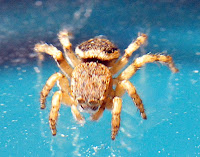Hello again, welcome back to animals under threat. So far
we have covered the Lion, Common agama, and the Red fox. Today, we will be
covering the Peacock spider (Maratus
Volans).
The Peacock spider is a small spider around 2-6mm that
belongs to the genus (Maratus), a
group of jumping spiders that resides in Australia. Female peacock spiders are
characterized by their dull brown/beige colour while males have brightly
coloured abdomens and elongated third legs that are brown/black tipped with
white (Girard & Endler, 2014).
Male spider on right by
Jurgen Otto and female spider on left by Australian Museum, Sydney
Peacock spider feed on a variety of insects, including
other spiders by stalking their prey. This has led to the peacock spider having
a wandering lifestyle in search of prey instead of waiting with a web like
other spiders (Girard & Endler, 2014). During the breeding season, male
peacock spiders will perch in an area that allows them to be seen by females. The
male peacock will wave its ornamented abdominal flaps and elongated third legs
to nearby females (Girard et al, 2015).
Male peacock spiders have to be careful
when displaying to females because if the male fails to impress the female
spider, the female will kill and eat him (Mendez et al, 2017). If he is
successful in his dance, he will be allowed to mate with the female. However,
after mating, the female kills and eat him. This happens in a lot of spider
species. Below is a video by Madeline B. Girard of a male peacock
spider performing a dance for a female.
As this species is relatively new and more are being
found in Australia, it is difficult to tell if humans have an impact on this
species. Environmental impacts can include loss of their natural habitat which
affects their prey that they feed on and global warming increasing temperature
leading to increased dry seasons in the rainforest.
Next time, we will be covering on a deer that is native
to East Asia and don’t lose it spots when they reach adulthood.
References
Girard, M.B. & Endler, J.A. 2014, "Peacock
spiders", Current Biology, vol. 24, no. 13, pp. R588-R590.
Girard, M.B., Elias, D.O. & Kasumovic, M.M. 2015,
"Female preference for multi-modal courtship: multiple signals are
important for male mating success in peacock spiders", Proceedings:
Biological Sciences, vol. 282, no. 1820, pp. 1-10.
Girard, Madeline B et al. “Multi-modal courtship in the
peacock spider, Maratus volans (O.P.-Cambridge, 1874).” PloS one vol. 6,9
(2011): e25390. doi:10.1371/journal.pone.0025390
Mendez, V., McGinley, R. & Taylor, P. 2017,
"Mating-induced sexual inhibition in the jumping spider Servaea incana
(Araneae: Salticidae): A fast-acting and long-lasting effect", PLOS ONE,
vol. 12, no. 10, pp. e0184940.
Picture references


No comments:
Post a Comment